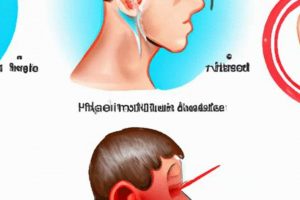The sensation of a buzzing or ringing sound in one ear, experienced without an external source, represents a specific type of tinnitus. This auditory perception can manifest as a high-pitched ringing, hissing, or, as described, a buzzing noise. Such experiences are subjective, meaning only the individual perceives the sound.
Understanding the underlying causes of this unilateral buzzing sound is important for effective management. It could stem from various factors, including exposure to loud noise, age-related hearing loss, earwax blockage, medication side effects, or underlying medical conditions such as Meniere’s disease. Identifying the root cause allows for targeted interventions and potential alleviation of the disruptive auditory perception.
Further investigation into this phenomenon will explore potential diagnostic methods, treatment options, and preventative measures. The subsequent sections will delve into the common triggers, available therapies, and lifestyle adjustments that individuals can adopt to manage and potentially minimize the occurrence of this specific type of subjective tinnitus.
Addressing Ear Buzzing
Experiencing a buzzing sensation in one ear can be unsettling. The following guidance provides practical steps to manage and potentially mitigate this auditory phenomenon.
Tip 1: Protect Hearing from Loud Noise. Prolonged exposure to high decibel levels can contribute to auditory damage, potentially triggering or exacerbating tinnitus. Utilize hearing protection such as earplugs or earmuffs in loud environments.
Tip 2: Manage Stress Levels. Stress and anxiety can worsen the perception of tinnitus. Implement relaxation techniques such as deep breathing exercises, meditation, or yoga to reduce stress and potentially lessen the buzzing sensation.
Tip 3: Limit Caffeine and Alcohol Consumption. Both caffeine and alcohol are known to affect blood flow and can sometimes exacerbate tinnitus symptoms. Reducing intake may provide some relief.
Tip 4: Monitor Blood Pressure. High blood pressure can impact blood flow to the inner ear and contribute to tinnitus. Regular monitoring and appropriate management of blood pressure may be beneficial.
Tip 5: Rule Out Medication Side Effects. Certain medications can have tinnitus as a side effect. Consult with a healthcare professional to review current medications and explore alternative options if necessary.
Tip 6: Seek Professional Evaluation. Persistent or bothersome buzzing in the ear warrants a thorough evaluation by an audiologist or otolaryngologist. This evaluation can help identify underlying causes and guide appropriate treatment strategies.
These practical steps represent initial measures that can be implemented to manage the sensation of ear buzzing. The efficacy of each tip may vary depending on the individual and the underlying cause of the tinnitus.
The subsequent sections will discuss further diagnostic and treatment options available for managing persistent or severe tinnitus.
1. Auditory Nerve Sensitivity
Auditory nerve sensitivity plays a critical role in the perception of tinnitus, particularly the specific auditory phenomenon described. Variations in the sensitivity and excitability of the auditory nerve can influence how the brain interprets neural signals, potentially leading to the sensation of a buzzing sound even in the absence of an external auditory stimulus.
- Spontaneous Neural Activity
The auditory nerve exhibits a baseline level of spontaneous neural activity. Increased sensitivity within the nerve can amplify this inherent activity, causing the brain to misinterpret it as a real sound. For instance, in cases of nerve damage, adjacent nerve fibers might become hyperexcitable, firing more frequently and creating the perception of a buzzing or ringing sound in the affected ear.
- Altered Synaptic Transmission
Sensitivity changes at the synapses of the auditory nerve can affect how auditory information is processed. Enhanced synaptic transmission can lead to exaggerated responses to subtle stimuli or even generate phantom sounds. This can occur due to imbalances in neurotransmitter levels or changes in receptor sensitivity within the auditory pathways.
- Auditory Nerve Fiber Damage
Damage to auditory nerve fibers, often resulting from noise exposure or ototoxic medications, can disrupt normal signaling patterns. Surviving nerve fibers may become more sensitive to compensate for the loss of input, leading to aberrant neural activity perceived as tinnitus. This compensatory mechanism can inadvertently contribute to the perception of a buzzing sound.
- Central Auditory Processing
The brain’s central auditory processing centers can also modulate auditory nerve sensitivity. Top-down influences from higher-level cognitive processes, such as attention and stress, can affect the gain and filtering of auditory signals. Heightened anxiety or stress can amplify the perception of tinnitus by increasing auditory nerve sensitivity, thus worsening the perceived buzzing sound.
The interplay between auditory nerve sensitivity and central auditory processing mechanisms underscores the complexity of tinnitus. While increased sensitivity can originate from peripheral factors like nerve damage or altered synaptic transmission, the brain’s modulation of these signals can significantly influence the subjective experience. Understanding these relationships is essential for developing effective management strategies that address both the peripheral and central components of the condition.
2. Inner Ear Dysfunction
Inner ear dysfunction represents a significant etiological factor in the manifestation of a buzzing sound in the ear. The intricate mechanics within the inner ear, specifically the cochlea, are responsible for converting sound waves into neural impulses. When this process is disrupted due to damage, disease, or age-related changes, aberrant neural activity can arise, which the brain interprets as tinnitus. Examples of such dysfunction include Meniere’s disease, characterized by endolymphatic hydrops, which distorts the delicate structures of the inner ear, frequently resulting in tinnitus described as ringing, roaring, or, less commonly, buzzing. Similarly, otosclerosis, an abnormal bone growth in the middle ear that can extend to the inner ear, can impair the proper transmission of sound, leading to similar auditory perceptions. Understanding the precise nature and location of inner ear impairment is crucial for tailoring effective diagnostic and therapeutic interventions.
The practical significance of understanding the connection between inner ear dysfunction and tinnitus lies in the ability to differentiate it from other potential causes, such as neurological disorders or medication side effects. Through audiometric testing, including pure-tone audiometry and tympanometry, clinicians can assess the integrity of the inner ear’s function. Imaging techniques, such as MRI or CT scans, may be employed to visualize structural abnormalities or lesions. This diagnostic information guides the selection of appropriate management strategies, which may include hearing aids to compensate for associated hearing loss, medication to manage underlying conditions like Meniere’s disease, or counseling to address the psychological impact of persistent tinnitus. It also informs decisions regarding the suitability of more invasive interventions, such as cochlear implantation in cases of severe hearing loss and intractable tinnitus.
In summary, inner ear dysfunction is a key component in the etiology of ear buzzing, necessitating a comprehensive assessment to determine the underlying cause and severity of the impairment. Challenges in addressing tinnitus arising from inner ear dysfunction include the complexity of the inner ear’s anatomy and physiology, as well as the limited reversibility of some forms of damage. Nonetheless, a thorough understanding of this connection remains fundamental for improving the management and reducing the impact of this bothersome auditory phenomenon. The interplay with other contributing factors must also be considered for a holistic approach.
3. Cochlear Hair Cell Damage
Cochlear hair cell damage is a primary mechanism underlying the perception of tinnitus, including the subjective experience of a buzzing sound in the ear. These specialized sensory cells, located within the cochlea of the inner ear, are responsible for transducing sound vibrations into electrical signals that the brain interprets as sound. Damage to these cells can result in aberrant neural activity, leading to the perception of sounds, such as buzzing, in the absence of an external stimulus.
- Mechanism of Damage
Cochlear hair cells can be damaged by various factors, including prolonged exposure to loud noise, ototoxic medications, age-related degeneration (presbycusis), and genetic predispositions. Excessive noise exposure is a common culprit, causing physical trauma to the delicate hair cells. Ototoxic drugs, such as certain antibiotics and chemotherapy agents, can also selectively damage these cells. As the hair cells degenerate, they may emit spontaneous electrical signals or become more sensitive to other stimuli, leading to the perception of tinnitus.
- Neural Signal Misinterpretation
When hair cells are damaged, they can fire erratically, sending abnormal signals to the auditory nerve. The brain, attempting to interpret these signals, may perceive them as a continuous sound, such as buzzing, ringing, or hissing. This misinterpretation occurs because the brain is wired to expect specific patterns of neural activity from healthy hair cells in response to external sounds. When these patterns are disrupted, the brain fills in the missing information, resulting in phantom auditory perceptions.
- Impact on Auditory Processing
Cochlear hair cell damage not only triggers tinnitus but can also affect auditory processing more broadly. Reduced hearing sensitivity, particularly at certain frequencies, is a common consequence of hair cell loss. This can make it difficult to hear and understand speech, especially in noisy environments. The brain may compensate for this hearing loss by increasing the gain on the remaining auditory signals, which can further exacerbate tinnitus. The combination of hearing loss and tinnitus can significantly impact an individual’s quality of life.
- Treatment and Management
There is currently no cure for cochlear hair cell damage, and the resulting tinnitus can be challenging to manage. Treatment strategies focus on alleviating symptoms and preventing further damage. Hearing protection is crucial for individuals at risk of noise-induced hearing loss. Hearing aids can help compensate for hearing loss and may also reduce tinnitus by restoring normal auditory input. Tinnitus retraining therapy (TRT) and cognitive behavioral therapy (CBT) can help individuals habituate to the sound and reduce its psychological impact. Further research is ongoing to explore potential regenerative therapies for cochlear hair cells, offering hope for future treatments.
In conclusion, cochlear hair cell damage represents a critical factor in the etiology of a buzzing sound in the ear. The mechanisms by which this damage occurs, the resulting misinterpretation of neural signals, and the impact on auditory processing all contribute to the complexity of this condition. Management strategies aim to mitigate symptoms and prevent further damage, with ongoing research seeking more effective and regenerative therapies. Understanding these aspects is essential for addressing the multifaceted challenges of tinnitus arising from cochlear hair cell damage.
4. Neurological Pathway Irritation
Irritation within the neurological pathways responsible for auditory processing can manifest as the perception of a buzzing sound in the ear. These pathways, extending from the inner ear to the auditory cortex in the brain, are susceptible to various forms of irritation that can disrupt normal signal transmission. Such irritation can arise from conditions such as multiple sclerosis, which causes demyelination of nerve fibers, or acoustic neuroma, a benign tumor that compresses the auditory nerve. The resulting aberrant neural activity is then interpreted by the brain as sound, even in the absence of external auditory stimuli. The impact of neurological pathway irritation is significant, as it represents a distinct etiology of this auditory phenomenon requiring specific diagnostic and management approaches.
Examples of conditions affecting neurological pathways and leading to tinnitus include vascular compression syndromes, where blood vessels impinge on the auditory nerve, causing irritation and abnormal firing. Furthermore, certain inflammatory or infectious processes affecting the brainstem or auditory cortex can also induce tinnitus. The practical significance of recognizing neurological pathway irritation as a potential cause lies in differentiating it from peripheral causes, such as inner ear damage. Diagnostic procedures, including magnetic resonance imaging (MRI) and evoked potential studies, are critical for identifying the presence and nature of neurological involvement. Subsequently, treatment strategies may include medication to manage inflammation or nerve pain, surgical intervention to relieve nerve compression, or rehabilitation therapies to mitigate the impact on auditory function.
In summary, neurological pathway irritation represents a significant, though less common, cause of a buzzing sound in the ear. It underscores the importance of considering the entire auditory pathway, from the inner ear to the brain, in the evaluation of this symptom. Challenges in diagnosis lie in the often subtle nature of neurological findings and the need for specialized investigations. Understanding this connection facilitates more targeted and effective management, aiming to alleviate the irritation and reduce the perception of unwanted auditory sensations.
5. Vascular System Influence
The vascular system’s influence on auditory function is a critical consideration when investigating the sensation of a buzzing sound in the ear. Proper blood flow to the inner ear and auditory pathways is essential for their optimal function. Disruptions in the vascular supply can lead to ischemia, turbulence, or pressure changes that can manifest as tinnitus, specifically described as a buzzing sound.
- Blood Flow Dynamics in the Inner Ear
The inner ear, including the cochlea and vestibular organs, relies on a delicate network of blood vessels for oxygen and nutrient delivery. Compromised blood flow, due to conditions like atherosclerosis or vasospasm, can deprive the sensitive hair cells of necessary resources, leading to dysfunction and the generation of aberrant neural signals. The subjective experience may be described as a buzzing, whooshing, or pulsatile sound, often synchronized with the heartbeat.
- Vascular Compression of Auditory Structures
In some instances, blood vessels may directly compress the auditory nerve or other auditory structures. This compression can cause irritation and abnormal firing of the nerve, resulting in tinnitus. An example includes vascular loops impinging on the auditory nerve near the brainstem. The resulting pressure can disrupt the normal transmission of auditory signals, leading to the perception of a buzzing or other phantom sounds.
- Systemic Vascular Conditions
Certain systemic vascular conditions, such as hypertension and hypotension, can impact inner ear blood flow. Elevated blood pressure can increase the risk of vascular damage and turbulence, while low blood pressure may lead to inadequate perfusion of the inner ear. These fluctuations can trigger or exacerbate tinnitus symptoms. Management of these systemic conditions is often crucial in alleviating the associated auditory perceptions.
- Pulsatile Tinnitus and Vascular Abnormalities
Pulsatile tinnitus, a type of tinnitus that presents as a rhythmic pulsing or throbbing sound, is often linked to vascular abnormalities. Conditions such as arteriovenous malformations (AVMs) or carotid artery stenosis can create turbulent blood flow near the ear, generating audible sounds. The sound is typically synchronized with the patient’s pulse and may be the manifestation of altered hemodynamics in close proximity to the inner ear. Diagnostic imaging, such as MRI or CT angiography, is often required to identify and characterize these vascular anomalies.
The facets of vascular system influence underscore the importance of considering circulatory health when evaluating auditory symptoms. Disruptions in blood flow, compression of auditory structures, systemic vascular conditions, and vascular abnormalities can all contribute to the perception of a buzzing sound in the ear. Recognizing and addressing these vascular components is crucial for effective diagnosis and management of this specific auditory phenomenon, which will involve working with a variety of healthcare professionals, including cardiologists or vascular surgeons, depending on the underlying cause.
Frequently Asked Questions Regarding Ear Buzzing
The following section addresses common inquiries concerning the sensation of a buzzing sound in one ear, providing concise and factual information.
Question 1: What potential conditions are commonly associated with a buzzing sensation in the ear?
Possible underlying conditions include noise-induced hearing loss, Meniere’s disease, earwax blockage, medication side effects, temporomandibular joint (TMJ) disorders, and in rare instances, vascular abnormalities.
Question 2: When should a healthcare professional be consulted regarding ear buzzing?
A medical evaluation is warranted if the buzzing sensation is persistent, unilateral, accompanied by hearing loss, dizziness, or other neurological symptoms, or if it significantly impacts daily life.
Question 3: What diagnostic tests are typically employed to assess the cause of ear buzzing?
Common diagnostic tests include audiometry to assess hearing, tympanometry to evaluate middle ear function, and in some cases, imaging studies such as MRI or CT scans to rule out structural abnormalities.
Question 4: Can lifestyle factors influence the experience of ear buzzing?
Certain lifestyle factors, such as exposure to loud noise, excessive caffeine or alcohol consumption, and high stress levels, may exacerbate the perception of tinnitus, including a buzzing sensation.
Question 5: Is there a definitive cure for ear buzzing?
A definitive cure may not always be possible, particularly if the underlying cause involves irreversible damage to the auditory system. However, various management strategies can help reduce the impact of the symptom.
Question 6: What management strategies are typically recommended for individuals experiencing ear buzzing?
Recommended management strategies may include hearing aids to compensate for hearing loss, tinnitus retraining therapy (TRT), cognitive behavioral therapy (CBT), sound therapy, and medication to address underlying conditions or associated anxiety and depression.
This FAQ section provides a general overview of common concerns related to ear buzzing. Individual circumstances may vary, and it is essential to consult with a healthcare professional for personalized guidance.
The subsequent section will discuss the potential impact of ear buzzing on an individual’s overall well-being and quality of life.
Conclusion
The exploration of “porque zumba un oido” has encompassed a spectrum of potential etiologies, ranging from inner ear dysfunction and cochlear hair cell damage to neurological pathway irritation and vascular system influences. A comprehensive understanding of these factors is crucial for effective diagnosis and management of this bothersome auditory phenomenon. The presented information serves as a foundational resource for both affected individuals and healthcare professionals seeking to navigate the complexities of this symptom.
Recognizing the multifaceted nature of ear buzzing, continued research into preventative measures, innovative therapies, and a holistic approach to patient care are imperative. A concerted effort towards enhancing our understanding of the underlying mechanisms and developing targeted interventions promises to improve the quality of life for those affected by this challenging condition. Further investigation and collaboration are essential to refine diagnostic capabilities and optimize treatment strategies in the pursuit of alleviating the burden imposed by this specific type of tinnitus.







